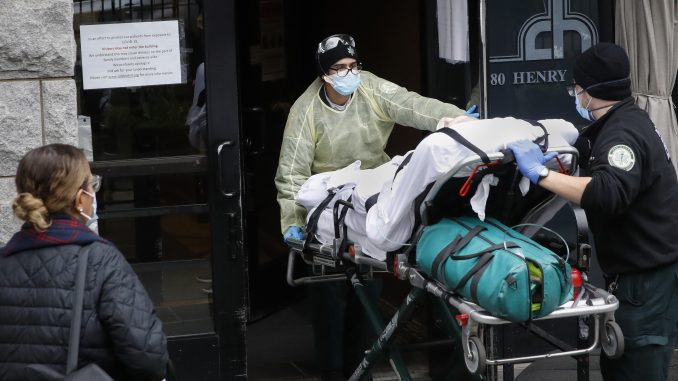
WASHINGTON, D.C. — A grim blame game with partisan overtones is breaking out over COVID-19 deaths among nursing home residents, a tiny slice of the population that represents a shockingly high proportion of Americans who have perished in the pandemic.
The Trump administration has been pointing to a segment of the industry — facilities with low federal ratings for infection control — and to some Democratic governors who required nursing homes to take recovering coronavirus patients.
Homes that followed federal infection control guidelines were largely able to contain the virus, asserts Seema Verma, head of the Centers for Medicare and Medicaid Services, or CMS, which sets standards and pays the bills. “Trying to finger-point and blame the federal government is absolutely ridiculous,” she says.
Verma says data collected by her agency suggest a connection between low ratings on safety inspections and COVID-19 outbreaks. But some academic researchers say their own work has found no such link.
Advocates say the federal government hasn’t provided needed virus testing and sufficient protective gear to allow nursing homes to operate safely. A White House directive to test all residents and staff has been met with an uneven response.
Nationwide, more than 45,500 residents and staff have died from coronavirus outbreaks at nursing homes and other long-term care facilities, according to a running count by The Associated Press. That’s about 40% of more than 115,000 total deaths. Nursing home residents are less than 1% of the U.S. population.
As with the rest of the country, nursing homes and congregate living settings in North Carolina have made up the majority of deaths in the state. Of the 1,118 deaths in the state as of June 15, 682 (61%) were in nursing home and assisted living facilities.
While North Carolina’s positive case numbers seem to be trending upwards, so is testing, which is still narrowly targeted to those who have symptoms or have had a greater chance of exposure.
“We are targeting our testing to people who are more likely to be positive,” North Carolina’s Department of Health and Human Services Secretary Mandy Cohen said at a recent COVID-19 briefing.
That rise in hospitalizations and congregate living deaths has caught the attention of White House Coronavirus Response Coordinator Dr. Deborah Birx. In a call earlier this month with Cohen, Birx said it was “some kind of systemic flaw” that had led the state to have a “defined slope in the number of cases” that goes back to the start of the pandemic. Referring to Birx’s conversation with Cohen, Congressman Dr. Greg Murphy (R-NC03) said Birx was “very emphatic” that the rise in metrics “did not have to do with reopening the state.”
Nearly three months into the outbreak and after increased scrutiny from the White House, NCDHHS has decided to begin full-scale testing of nursing homes and similar facilities. According to a report by Travis Fain, of the Raleigh television station WRAL, “Decisions we made on testing, to not testing people coming in to nursing homes in March and much of April, unless they showed symptoms, may have let the virus into homes it otherwise wouldn’t have affected.”
Lack of testing is one part of the North Carolina nursing home problem. The other part is data transparency involving both hospitalizations and congregate living case tracking. The most recent congregate living setting report tracks upwards of 67 outbreaks in nursing facilities, yet the NCDHHS data dashboard claimed there are over 160 outbreaks. Over the weekend, the number rose by at least one as another outbreak was reported at the Windsor Point long-term care facility in Fuquay-Varina located in Wake County.
The NCDHHS dashboard does not give any details on hospitalizations beyond the total number, rendering the statistic unusable for tracking counties or the how many are attributed to congregate living outbreaks.
During a recent congressional briefing, Rep. Steve Scalise of Louisiana, the No. 2 House Republican, blamed New York Democratic Gov. Andrew Cuomo for the high numbers of deaths in his state. A since-rescinded state directive that nursing homes must accept recovering coronavirus patients “ended up being a death sentence” in New York and several states with similar policies, Scalise said.
Scalise echoed earlier comments from CMS head Verma, who has said such state orders were “not appropriate” and “may have contributed to this issue as well.”
But Harvard researcher David Grabowski, who serves on a nonpartisan commission advising Congress about Medicare, says neither state policies, nor “bad apples” among nursing homes, have driven the outbreak.
Grabowski says because the virus can be spread by people who show no symptoms, that means if it’s already in a community, the staff can unwittingly bring it into the nursing home. Once inside it easily spreads among frail residents living in close quarters.
“The secret weapon behind COVID is that is spreads in the absence of any symptoms,” Grabowski told lawmakers at a recent briefing. “If COVID is in a community where staff lives, it is soon to be in the facility where they work.”
CMS head Verma said her agency has been on top of things from the beginning, issuing numerous safety guidelines for nursing homes, setting new coronavirus reporting requirements, and providing Medicare payment for testing residents. She says states have money from the federal government that they can use to support testing of nursing home staff.
The nursing home industry says just one-time testing for every resident and staffer would cost $440 million, and facilities struggling financially would not be able to bear the expense of regular staff testing.
Rep. James Clyburn of South Carolina, the third-ranking House Democrat and chairman of a special panel on the pandemic, says the crisis in nursing homes should not be a partisan issue.
“Nursing home residents have died from the coronavirus in states governed by Republicans and Democrats, in big cities and in small towns, in rural and urban communities,” Clyburn said.
Appearing before Clyburn’s committee last week, Alison Lolley of Monroe, Louisiana, told of losing her 81-year-old mother, Cheryl, to COVID-19 in a nursing home outbreak this spring. The family was not allowed to be with her.
“My family was robbed,” Lolley said. “Mama was trapped in a petri dish, and we were shut out. Mama died alone and our family will forever be scarred by this tragedy.”



